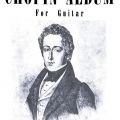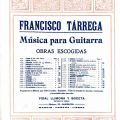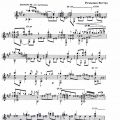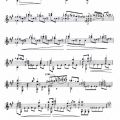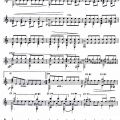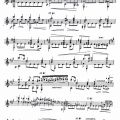What is the link between a pickled human heart, the rise of the middle class, and the oldest musical instrument? The answer lies in Special Collections & Archives. Housed within the Vahdah Olcott-Bickford Collection is a transcription by Fransisco Tárrega of Chopin’s Prelude Op. 28, No. 15 for the guitar. This is a particularly unique item considering the history of the guitar. 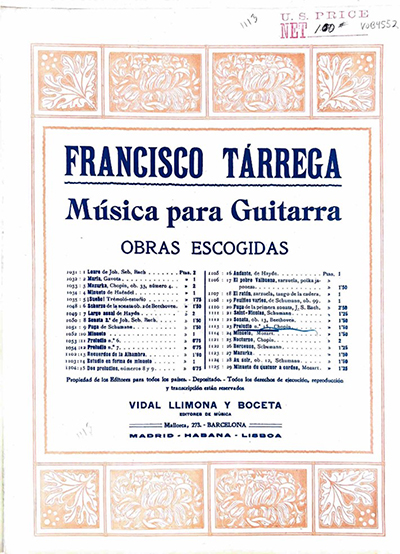
In a 2022 OnePoll survey of 2,000 participants, guitar, with 38% favorability, was by far the most popular instrument, followed by piano/keyboard at 27%, and several third-place contenders hovering around 18%. Such is the guitar’s popularity that statistically, you are twice as likely to prefer it to the sound of your own voice. Incredible, when considering that one is the oldest musical instrument, culminating thousands of years of evolution and/or proof of intelligent design, while the other is the human voice.
This enduring popularity can’t be attributed to a single distinct feature. Rather, the guitar is a unique amalgam of many musical qualities in a miniaturized package, “a small orchestra,” as described by the illustrious guitarist Andres Segovia. The etymology of guitar leads back to the Indo-Iranian root word “tar,” meaning ‘string’ or ‘strand.’ Like all chordophones, whose mechanism for sound production is a string under tension, the guitar’s origins can be traced back to the bow and arrow of early hunter-gatherers. Its components were as readily available then as they are now. Thus, they are moldable, portable, and, above all, affordable, making guitars the darling of the working class. But, popularity does not always portend respectability.
The idea of the guitar as a respectable classical instrument took shape during the last one hundred years. By contrast, the invention of the piano in the eighteenth century coincided with the rise of the merchant class. The piano was a bourgeoisie status symbol. Consequently, the greatest composers composed their greatest works for piano at far greater rates than for guitar. Except for a bedridden Franz Schubert, who is said to have used guitar to write during his frequent bouts of illness, the piano was the default choice for the romantic era composers.
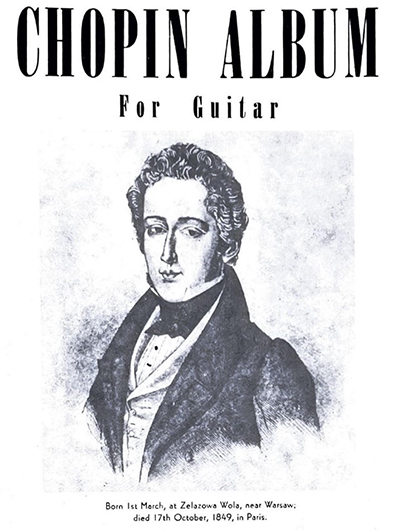 "Romanticism", or the "Romantic era", is the term given to the period of immense political and artistic vitality from the end of the eighteenth until the mid-nineteenth century, whose lasting legacy includes the archetypal tortured artist, the cult of individualism that culminates in LA driving attitudes, and the tears you couldn’t hold back during “Les Misérables.” Classical music in this period, including guitar and piano, arguably reached its apex. While the guitar canon includes works by many great composers from this era, for every Tárrega or Barrios writing for guitar, ten legends like Beethoven, Schumann, and Liszt wrote for the piano. Guitarists may begrudgingly pretend otherwise, but they’ve been secretly eating their hearts out since then. And, with that reference to esculent hearts, we come full circle to the opening question.
"Romanticism", or the "Romantic era", is the term given to the period of immense political and artistic vitality from the end of the eighteenth until the mid-nineteenth century, whose lasting legacy includes the archetypal tortured artist, the cult of individualism that culminates in LA driving attitudes, and the tears you couldn’t hold back during “Les Misérables.” Classical music in this period, including guitar and piano, arguably reached its apex. While the guitar canon includes works by many great composers from this era, for every Tárrega or Barrios writing for guitar, ten legends like Beethoven, Schumann, and Liszt wrote for the piano. Guitarists may begrudgingly pretend otherwise, but they’ve been secretly eating their hearts out since then. And, with that reference to esculent hearts, we come full circle to the opening question.
With a stereotypically short life from 1810-1849, the top choice for any fantasy-composer draft, the stubborn genius who wrote exclusively for the piano, the embodiment of romantic fatalism living in exile whose final wish was for his pickled heart to be taken back to his Polish homeland, is none other than Frédéric Chopin. Chopin is known for his infamously grueling piano etudes or studies that are impossible to play on guitar, even with an extra pair of hands. Luckily, he is equally celebrated for his tranquil preludes and nocturnes, intimate works that suit the guitar’s delicate timbre. Still, transcribing Chopin for guitar can only be trusted by a musician of equal caliber. Fortunately, the father of the classical guitar, Francisco Tárrega (1852-1909), bequeathed the guitar canon with such pieces as Capricho Árabe and Recuerdos de la Alhambra also handed down the best arrangements of Chopin’s works for the guitar. Among them is a transcription of one of Chopin’s most widely recognized works, the Prelude Op. 28, No. 15, better known as the “Raindrop.” This transcription is but a drop in a bucket within the larger Vahdah Olcott-Bickford Collection, which is available in Special Collections & Archives for research and viewing.



